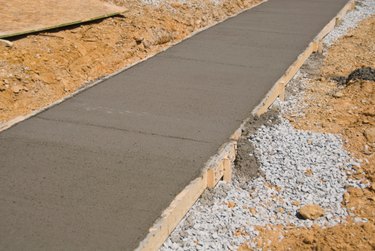
Cement is commonly made from a mixture of Portland cement, sand and gravel or crushed stone. Once the components are combined, they are hydrated with water to form a heavy, dense substance that eventually solidifies into a rock-hard mass. Various masonry tools are used to push, pull and finish cement so that it's polished when hardening into its intended place.
Shovel
Video of the Day
A shorthanded, square-edged shovel is the best tool to dole out fresh, newly mixed concrete, according to the American Concrete Institute's book "Guide for Concrete Floor and Slab Construction." Another tool that can be used is a "come-along," a hoe-like tool with a long rectangular blade. Both tools can be used to push the cement back and forth, to level it -- a process called "screeding." The tool must be substantial enough to push around the heavy mixture without bending, as cement can weight up to 150 lbs. per cubic foot.
Video of the Day
Rake
For larger cement jobs, workers might use a handheld tool with a longer blade known as a cement rake. This instrument has a blade that's usually fashioned out of magnesium, which is available in 36 and 42 inches. Though the rake is usually lightweight for easy handling, it's durable enough to spread the cement mixture. The blade is at the end of the long wooden handle, which is usually double-sided. One side is smooth for leveling the cement; the other has teeth and can be used to distribute gravel-based mixtures, such as asphalt.
Float
Once the cement has been distributed within the wooden frame and leveled, the float tool is used to help make the cement more compact and pull it to the surface. The float is a flat magnesium blade that has a wooden small wooden handle affixed to one side, and the other side has full contact with the cement. The water must first settle before the magnesium tool is used. Then, the handheld float tool can be swept across the surface. This helps reduce the gritty appearance of the mixture. When floating the cement, it's best to start with small sections. Puddles in the mixture mean that the floating tool was used too early. This can result in cracking or a dull finish to the surface of the cement, according to the article "Tools: Basic Masonry Tool Kit."
Trowel
The trowel is the final finishing tool in the cement-spreading arsenal. It helps polish the cement. Cement jobs that need an extra level of refinement sometimes use two trowels, according to the book "Black & Decker The Complete Outdoor Builder: From Arbors to Walkways: 150 DIY Projects" by Creative Publishing International. The trowel has a flat aluminum rectangular blade with a wooden handle affixed to one side. To use the instrument, sweep the flat blade across the cement in half-circular motions. This helps polish the cement's surface, the final touch to the spreading process.